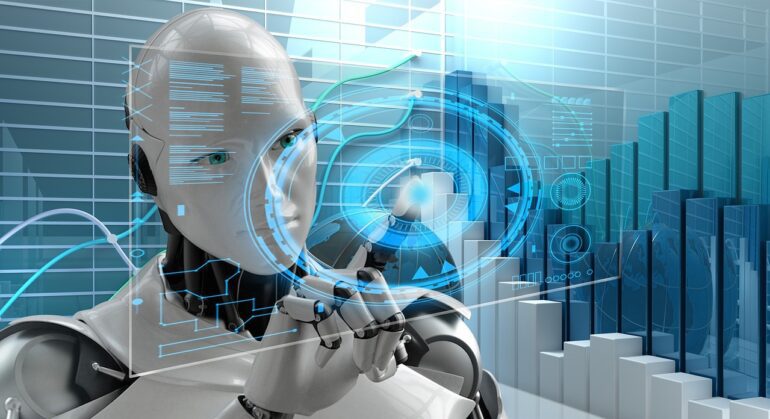TL;DR:
- AI in robotics is revolutionizing industries and driving technological advancements.
- The goal is to replicate human brain thinking and enable machines to make decisions based on information.
- The integration of algorithms and sensor data analysis empowers robots with AI tools.
- Collaboration between AI and robotics leads to the development of sophisticated and autonomous systems.
- AI in robotics automates tasks, enhances precision, and increases productivity in various industries.
- Applications include autonomous navigation, object manipulation, and healthcare interventions.
- Machine learning plays a crucial role in industrial robots and production efficiency.
- AI and robotics advancements enable intricate surgeries with precision and minimally invasive procedures.
- Big data and AI contribute to health diagnostics.
- The future holds limitless possibilities as AI and robotics continue to evolve and synergize.
Main AI News:
The realm of artificial intelligence (AI) in robotics has witnessed a revolution, reshaping industries and paving the way for countless applications. As the demand for AI continues to surge, the synergy between these two fields intensifies, driving innovation and pushing the boundaries of technological possibilities. In this article, we delve into the profound impact of AI in robotics and explore the expanding horizons it offers.
At its core, the pursuit of AI in robotics aims to emulate the intricate workings of the human brain. This entails crafting computer programs that enable machines to make informed decisions based on the information derived from engineering, electronics, and, significantly, computing. The amalgamation of these disciplines culminates in the multifaceted science of cybernetics, amplifying the capabilities of these automatons and blurring the lines between AI and robotics.
A pivotal aspect of this synergy lies in the integration of algorithms and techniques that empower robots with AI tools to analyze sensor data from their environment. This enables them to learn autonomously and make real-time decisions, thereby facilitating appropriate movements and interactions with their surroundings. Consequently, these intelligent machines gain a profound understanding of their environment, enhancing their adaptability and functionality.
The collaboration between AI and robotics has sparked the development of sophisticated autonomous systems, marking a remarkable stride forward. Robotics serves as a real-world testing ground, furnishing AI with invaluable examples and datasets for training machine learning algorithms. This synergy also facilitates cutting-edge advancements in reinforcement learning and artificial intelligence methodologies, pushing the boundaries of what robots can achieve.
The advantages of AI in robotics are particularly pronounced in the automation of tasks that add little value, pose risks to human safety in hazardous environments, or demand precision and speed. Beyond the realm of manufacturing, robotics finds applications in diverse industries, including healthcare. It empowers precise surgeries and lab work, enabling remote interventions and delivering remarkable precision in intricate procedures.
Moreover, the integration of AI in robotics unlocks a plethora of possibilities, such as autonomous navigation. Machines equipped with state-of-the-art sensors, computer vision, and machine learning systems can effortlessly navigate unfamiliar territories. By leveraging meticulously crafted algorithms, these robots can detect and manipulate objects, calculate distances, and evade obstacles. Even in perilous or inaccessible locations, they navigate seamlessly, mapping their surroundings and operating autonomously without constant human intervention.
The manipulation of objects follows a similar trajectory, as sensors provide vital information for adjusting grip force according to the object being handled and the task at hand. This technology fosters precision and efficiency, bolstering the robot’s expertise in manipulating various objects. It is crucial to note that these instruments are designed to work harmoniously with humans, and their ability to adapt swiftly to diverse scenarios is steadily improving.
The field of AI in robotics is continuously expanding, accompanied by extensive research and development endeavors. For instance, machine learning plays a pivotal role in industrial robots, augmenting production capacity while minimizing errors on assembly lines and enhancing overall efficiency. The advent of autonomous mobile robots (AMRs) has emerged as a prominent trend, exemplifying the convergence of AI and robotics.
Moreover, AI’s integration propels these instruments to tackle increasingly intricate tasks, including soldering and assembling electrical components, as well as performing intricate surgeries with heightened precision, accuracy, and minimally invasive procedures. Furthermore, the use of AI and machine learning, coupled with big data technologies, is revolutionizing health diagnostics, enabling the gathering and analysis of vast amounts of relevant data.
Conlcusion:
The integration of AI in robotics signifies a paradigm shift with profound implications for the market. This convergence has unleashed a wave of innovation, empowering industries to achieve unprecedented levels of automation, precision, and productivity. Companies that embrace these advancements gain a competitive edge by streamlining operations, reducing costs, and enhancing efficiency.
Moreover, the limitless potential of AI in robotics opens doors to new markets and opportunities where intelligent machines can revolutionize sectors ranging from manufacturing to healthcare. To stay ahead in this dynamic landscape, businesses must recognize the transformative power of AI in robotics and proactively leverage its capabilities to drive growth, meet evolving customer demands, and seize the vast potential for innovation. By embracing this transformative synergy, organizations can unlock a world of possibilities and secure a prosperous future in the ever-evolving market.

